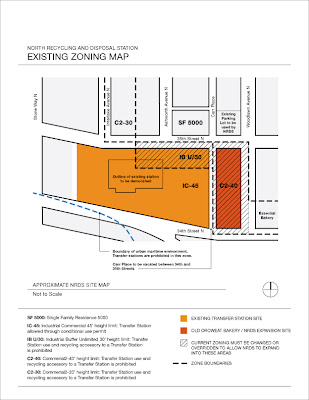skip to main |
skip to sidebar
The image below shows the current zoning conditions of the North Recycling and Disposal Station and the surrounding areas.
The hatched area of the map shows two different zones that NRDS would like to expand their facilities into. To do this, current zoning must be changed or overridden.
The Seattle Department of Planning and Development (DPD) has advised that SPU confine their rebuild to the IC-45 zone.
Click on the image to enlarge.
This is a reminder that the North Recycling and Disposal Station Stakeholder Group will be meeting next Tuesday, April 21st from 6-8 pm. Food and refreshments start at 5:30 pm. It's at Hamilton Middle School Library, 2nd Floor, 4400 Interlake Ave N.
Reminder: Hamilton Middle School is temporarily located at the old Lincoln High School. Please enter at the Interlake Avenue entrance.
Below is a document that SPU distributed at a recent Wallingford Community Council meeting. It discusses why they are rebuilding the Recycling and Disposal Station, what's planned for the new station and the proposed benefits to our neighborhood.

NESTS met with Councilmember Nick Licata on March 6th to discuss the plans for the North Transfer Station and the need for an Environmental Impact Statement prior to proceeding with the design, demolition, rebuilding and enlargement of the Station.
We expressed our concern about the toxicity on the site, storm water run off, traffic and noise. We also expressed our concern that the size and design of the facility will have a negative impact on the neighborhood. In addition, there appear to be significant zoning issues involved.
We recently received a letter from Mr. Licata that was sent to the Acting Director of Seattle Public Utilities (SPU) expressing his support for an Environmental Impact Statement on the North Transfer Station before proceeding.
NESTS thanks Councilmember Licata for his support and commitment to our neighborhood.

IMPACT ON OUR NEIGHBORHOOD
Seattle Public Utilities (SPU) plans to tear down, rebuild and expand the existing transfer station. The new station will include a recycling center, transfer station and SPU offices. The new facility will cover the existing site and incorporate Carr Street between 34th and 35th and the commercial building to the east (across from the Essential Bakery).
The new buildings could be up to 40' to 45' tall (the size of a 4 story building) and come within 0' to 5' of the property line. 90% of the site will be covered with buildings or paving. Current zoning prohibits recycling connected to a transfer station on much of the expansion site and appears to prohibit expansion towards the residential neighborhood — it appears that SPU may try to waive the current zoning standards or have the property rezoned in order to move forward with their current plans. The facility expansion could increase greenhouse gas emissions and traffic. It will likely block views of Queen Anne Hill, the Space Needle, Lake Union, the Ship Canal and Aurora Bridge for many residential neighbors. SPU says that current trees and plantings around the site could be destroyed — why did they plant new trees if the buffer could be torn up?
ENVIRONMENTAL CONCERNS
SPU has documented that hazardous waste is going through these facilities and admitted in a 1998 report that even small amounts can cause health risks, harm workers and cause environmental problems. SPU recently released results of soil tests done on the site in 2008, and contamination was found. We’ll post more information regarding the study on our blog. Apart from the daily waste exposure, the site contained two underground auto fuel storage tanks.
Knowing this information, SPU has still decided NOT to do an Environmental Impact Statement (EIS).
WHY AN ENVIRONMENTAL IMPACT STATEMENT IS IMPORTANT
An EIS would identify the issues — impact on the neighborhood, zoning, transportation, air quality, odor, noise, building design, ground water, water run-off, and hazardous material — and possible alternative sites. An EIS is the required process for developing enforceable mitigation for identified impacts. Without an EIS, we have less leverage to make sure the project is done well, regardless of where it is built.
WHAT CAN YOU DO TO HELP?
• Write a letter, or email your city council members voicing your concerns
• Sign a petition asking SPU to prepare an EIS, and get your friends and neighbors to sign it
EMAIL US FOR MORE INFORMATION



